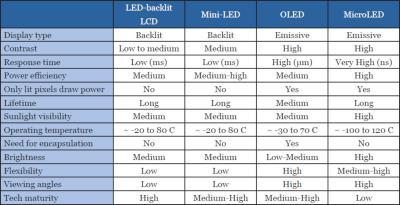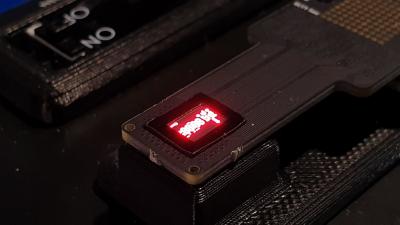MicroLED displays are exciting to many, as the technology seems to be the front runner for the next-generation display of choice in many market segments - from AR/VR glasses through wearables to TVs and IT displays.

The MicroLED industry though, even after billions of dollars spent on R&D, is still at a very early stage. Production costs are high, processes are not reliable enough, and there are several technical challenges to overcome before production can begin (except for some niche areas such as ultra large-size premium TVs).
If we assume these challenges will be overcome in the future, and reliable and low-cost production processes will emerge, how will microLED displays far against OLEDs?
The main advantages of microLED displays will be the high power efficiency and high brightness, and long lifetime of the LEDs and the ability to create very small pixels. In addition, the technology enables unique business models, and sometimes unique designs which may enable it to succeed in certain applications.
MicroLEDs: high brightness and power efficiency
High brightness and power efficiency are key to the success of microLEDs in many applications - especially in mobile devices, wearables and AR/VR solutions. In fact most AR developers believe microLEDs could be very successful as the extreme high brightness potential is very useful.

High-brightness MicroLED microdisplay prototype
While microLEDs theoretically indeed offer very high brightness / efficiency, in real life the advantages gets eroded when the LEDs get smaller, and in addition the backplane design can be critical for power consumption as well. This issue was covered in a series of articles at MicroLED-Info.
MicroLED vs OLED: lifetime and burn-in
The long lifetime of the in-organic LEDs, compared to those of OLEDs, is a major advantage - and will limit the burn-in effect that is one of the main challenges of the OLED technology. This is a true advantage for the technology - but will consumers agree to pay more money for displays with less burn-in? After all, today consumers buy millions of devices annually with OLED displays (hundreds of millions, actually) - wearables, smartphones, tablets, laptops and TVs, and in real life not many of these devices actually suffer from burn-in.
I can personally say that I have an OLED TV since 2016, with not burn-in at all. I have had many AMOLED smartphones (starting with the Samsung Galaxy S back in 2010) and never had any issues. I think most consumers have the same experience, and so the mitigation of burn-in by microLEDs (or the almost mitigation, anyway) may not prove to be a great marketing advantage.
MicroLEDs: unique models
One of the most interesting traits of MicroLED technology is the breakout from traditional production processes. OLED displays are produced on large glass substrates, where all layers are deposited one after the other. This is also true for LCDs. The larger the substrate, the more efficiency the process is - which caused the industry to invest in very large production lines that are very efficient. These lines are highly expensive and required very specific conditions (due to the sensitivity of OLED materials) and supply chains - which resulted in the relocation of the entire display industry into Korea, China, Taiwan and Japan.
But MicroLEDs can be produced in different ways - for example the technology enables the seamless tiling of small modules into larger displays (this is not possible with OLEDs). This means that the large substrate requirement may no longer be true - and production can be split between several geographic locations. This could mean that new business models may emerge and new display makers and even end-customers may produce their own panels.
It is too early to tell, but this could certainly be a trend that challenges traditional LCD and OLED display production models.
MicroLED vs OLED: Final thoughts
The microLED display industry is still at an early stage. The market is not really here yet, and it is likely to take years before we see actual production of displays for consumer devices.
We do not yet have a path towards actual market adoption, but many companies are betting that once production processes stabilize and costs drop, microLEDs will find market niches and eventually large market success due to some of the inherent advantages.
Whether that will happen is too early to tell, especially as OLED technologies are improving all the time.
Comments
Yes, we don't discuss it here. It is likely that MicroLEDs and OLEDs will share pretty much the same (excellent) contrast.
Technically the same contrast ratio (infinity to one), but practically speaking, MicroLED can have much greater actual contrast. They both have absolute zero black levels, which gives them that ratio, but MicroLED has a higher maximum brightness.


Absent from this article is MicroLEDs contrast performance.